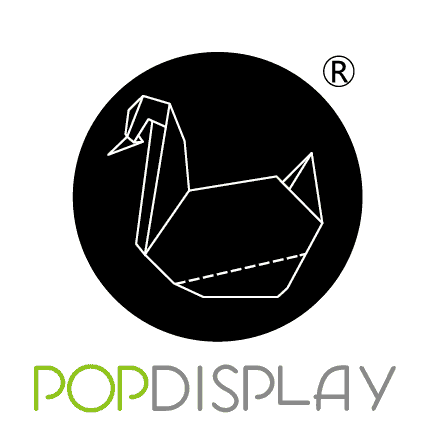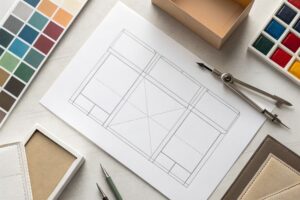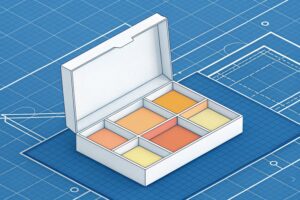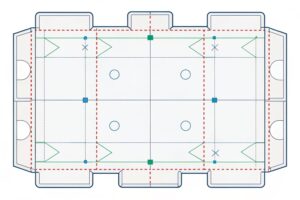I know budgets are tight. I also know presentation matters. I help buyers get premium looks without premium waste by matching structure, board, and print to the job.
Yes. I offer cost-effective rigid box options by swapping full chipboard for hybrid cores, using paper-over-board wraps, right-sizing walls, simplifying inserts, and moving finishes to print coatings. These changes keep the premium look and drop unit cost without hurting strength.

I will show clear choices. I will explain where money goes. I will use my own shop stories so you can judge trade-offs fast and order with less stress.
Are rigid boxes expensive?
Price can feel high when the box looks simple. Price comes from hidden parts. Glue lines, wrap paper, cores, magnets, and hand work add time and risk.
Rigid boxes cost more than folding cartons because they use thicker board, wrap paper, more hand assembly, extra lining, and premium finishes; unit cost rises with size, magnets, lids, foam, small batches, and tight color control.

How I break down cost and shave it where it counts
I run a display and packaging line that builds POP and gift sets for launches. I learned that rigid boxes act like small furniture. Each surface needs a wrap. Each corner needs a turn-in. Labor stacks up. I start with a cost map1. I list board, wrap, lining, insert, finishing, and assembly. Then I cut weight where the brand will not see or feel a loss. I change full rigid walls to strategic panels. I keep the touch points premium. I keep the hinge clean.
| Cost Driver | Why it Adds Cost | My Lower-Cost Swap | Impact on Look | Impact on Strength |
|---|---|---|---|---|
| Core thickness | More chipboard = more cost | Hybrid: 1.5–2.0 mm core + reinforced edges | Same to the eye | Same for retail |
| Wrap paper | Textures and laminates | Printed kraft or art paper + AQ coating | 95% same | Same if coated |
| Magnets | Hardware + alignment | Ribbon pull or friction fit | Slight change | No loss |
| Inserts | CNC foam is pricey | E-flute or molded pulp2 | Modern eco feel | Good with test |
| Small runs | Setup waste is high | Gang runs and standard sizes | Neutral | Neutral |
I used this method for a hunting accessory kit launch. The buyer wanted a hard two-piece box with dense foam. I proposed molded pulp with a thin printed top pad. He cut insert cost by 40% and met his sell-in date.
What are the disadvantages of rigid boxes?
Rigid boxes look great. They are not perfect for every job. They need care in design and shipping. I tell clients this before we quote.
Rigid boxes weigh more, cost more to ship, take more storage space, scuff faster without lamination, and need more hand work that can slow lead time. They also use more materials than cartons.
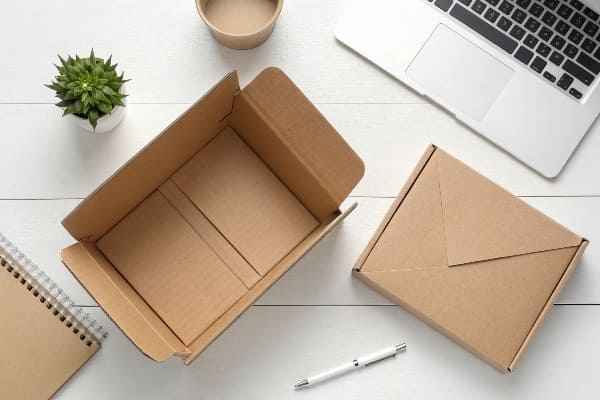
Where rigid boxes can hurt and how I blunt the pain
I split risks into use, logistics, and sustainability. Use risks include edge scuffing and lid looseness. Logistics risks include cube waste and damage in transit. Sustainability risks include mixed material wraps. I run transport tests3 early. I use corner boards or fold-flat “setup later” designs when volume is large. I also replace plastic films with water-based coatings. When a brand needs a premium gift feel at Costco or Walmart, I align the rigid box with a corrugated PDQ or tray that protects corners. This blends my display practice with the box build so the aisle looks sharp and survives.
| Disadvantage | Real-World Effect | Fix I Use | Result |
|---|---|---|---|
| Weight and cube | Higher freight and pallet count | Right-size, thin wall, nested lids | Lower freight per unit |
| Scuffing | Edges mark in handling | Anti-scuff varnish, edge guards | Cleaner retail look |
| Slow assembly | Hand work bottlenecks | Jigs, pre-taped wraps, training | Faster, steadier yield |
| Sustainability | Mixed wrap hard to recycle | Mono-paper wrap, water-based inks | Better claim, easier recycle |
| Damage risk | Corners crush in transit | PDQ shippers, inner trays | Fewer returns |
I saw one crossbow accessory set fail a drop test at 60 cm. The fix was not a thicker wall. The fix was a tight inner tray lock and a PDQ that hugged the corners. Cost went up 3%, damage rate dropped near zero.
Why are custom boxes so expensive?
Custom means new dies, new jigs, new checks. There is a learning curve on the first run. I like to be direct about this part.
Custom boxes cost more due to design time, die tooling, color proofing, slow first-run setup, higher scrap during dialing-in, and small MOQs; price drops on repeat runs when tools and checks are stable.
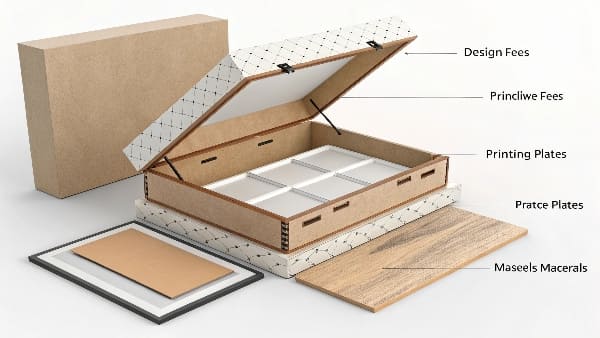
What “custom” really buys and how I compress the first-run premium4
Custom buys control. You set wall height, lid friction, reveal, and unboxing pace. The first run needs extra proof steps. I build a roadmap that keeps speed and quality. Step one is a CAD and 3D render. Step two is a white dummy to test size. Step three is a printed sample for color and touch. I do free tweaks until you sign off. I record torque for friction fit lids. I log glue type and open time so lines repeat. On repeat orders, I lock a standard BOM so you do not pay for guesswork again.
| Cost Stage | What Happens | How I Reduce Cost | Effect on Lead Time |
|---|---|---|---|
| Design | CAD, dielines, 3D | Template library, reuse inserts | Shorter |
| Tooling | Cutting dies, jigs | Shared tooling where fit allows | Lower one-time fee |
| Proofing | Color and fit | Digital proofs + one press sheet | Fewer rounds |
| First Run | Slow setup | SOPs, checklists, training | Faster ramp |
| Repeat | Stable SOP | Lean changeover, gang print | Lower unit cost |
In my Shenzhen shift last fall, a brand pushed a tight date for a holiday set. We used a stock base size with a custom lid height and an off-the-shelf molded pulp tray. The set looked unique. The first run landed on time. The next reorder dropped 18% in unit cost.
What are the benefits of custom two piece rigid boxes?
Two-piece rigid boxes lead in gift and premium. The lid lift feels good. The reveal is clean. Buyers remember that feeling. That is why this style stays strong.
Two-piece rigid boxes give a premium unboxing, clear brand panels, easy stacking, simple inserts, flexible sizes, and strong shelf presence; they balance cost and look when sized right and paired with smart materials.
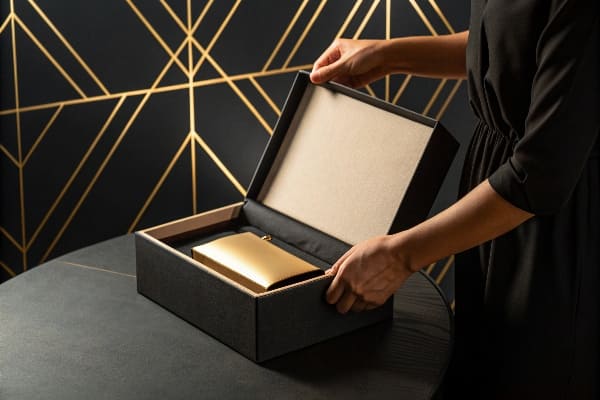
Why the classic lid-and-base still wins for retail and gifts
I like two-piece boxes5 because they scale. I can set the lid depth for the reveal you want. I can run friction fit without magnets. I can print bold on all sides. In display programs, I place these boxes into PDQ trays or pallet displays so the brand wall is strong from far away. I often print a story panel under the lid. This adds value without adding parts. For inserts, I swap foam for die-cut E-flute or molded pulp when the product allows. This saves money and supports eco goals6. For color, I use water-based inks and an anti-scuff top coat. That keeps edges clean under store lights.
| Benefit | How It Helps | My Build Tip | Added Value |
|---|---|---|---|
| Premium feel | Slow lid reveal | 15–20 mm lid overlap | Better unboxing |
| Brand space | 5 printable panels | Keep spine for logo | Strong recall |
| Stack and ship | Flat top and base | Test friction fit | Fewer damages |
| Simple inserts | Tray or die-cut | Use E-flute or pulp | Lower cost, greener |
| Flex sizes | Easy dieline tweaks | Use size ladder | Faster quotes |
A hunting tools client needed a rugged look. We used kraft wrap with bold black type and a deep lid. We cut a finger notch so the lid lifted smooth, even with gloves. The box sat inside a corrugated counter display with a quick “grab one” message. The set sold out, and the reorder kept the same dieline, so cost stayed low.
Conclusion
Cost control does not fight beauty. I tune structure, materials, and process so your rigid boxes look premium, ship safe, and meet deadlines without blowing the budget.
Understanding a cost map can help you optimize your packaging expenses effectively. ↩
Exploring molded pulp can reveal sustainable and cost-effective packaging solutions for your products. ↩
Exploring transport tests can reveal best practices for ensuring product safety during shipping. ↩
Discover strategies to minimize first-run premiums, ensuring cost-effective production without compromising quality. ↩
Explore the benefits of two-piece boxes for retail packaging, including scalability and design flexibility. ↩
Learn how sustainable packaging practices can help brands meet their eco goals while appealing to environmentally conscious consumers. ↩
